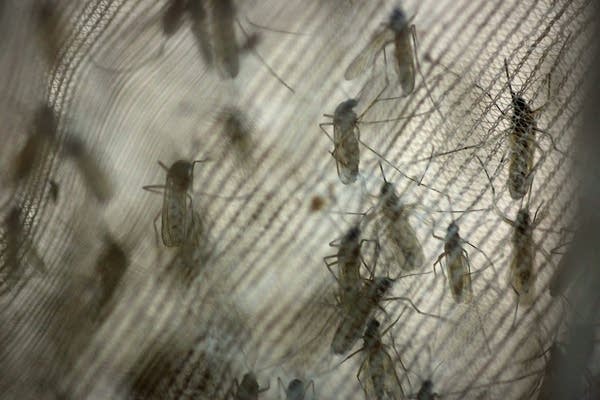Mosquitoes: A summer survival guide

Minnesotans know: A beautiful summer day can suddenly turn treacherous at dusk. That's when the mosquitoes come out in force.
Here's what you need to know about summer's most pesky pest.
There's not just one kind of mosquito
Create a More Connected Minnesota
MPR News is your trusted resource for the news you need. With your support, MPR News brings accessible, courageous journalism and authentic conversation to everyone - free of paywalls and barriers. Your gift makes a difference.
Those mosquitoes may all look the same as they perch on your arm, but there's actually great variety in Minnesota's mosquito population — there are 51 species present in the state; 45 are found in the metro area.
These species can be grouped into two categories: Spring species and summer species.
Spring species only produce one generation of mosquitoes per year, and the adults can live three to four months. They lay eggs in the summer, but those eggs need to freeze before they can hatch, which usually happens in early spring after snowmelt or cooler rains.
Summer species can have multiple generations per year. They also don't live as long as their spring species counterparts — usually only a few weeks.
Those differences make it hard to make generalizations about Minnesota mosquitoes. "The different species have some specific likes and dislikes as far as where they like to lay their eggs; how long they live; where they like to hang out; whether they're active during the day or at night," said Sandy Brogren, chief entomologist of the Metropolitan Mosquito Control District.
Mosquitoes need water to breed
Mosquitoes lay many eggs at a time, usually between 150 to 200. Aedes vexans, Minnesota's most common mosquito species, likes to lay eggs on the ground at water level, where the water will gather when it rains. Once the eggs are covered by one to two inches of water, they will hatch.
In the water, these larvae will go through a complete metamorphosis (like a butterfly) in order to become a mosquito. After the larval stage, they turn into pupae and then eventually emerge from the pupa as an adult mosquito. This transformation usually takes seven to 10 days.

Only female mosquitoes bite
Female mosquitoes need blood to develop eggs, so they're the only ones that bite.
Mosquitoes are attracted to humans through the carbon dioxide we exhale — and through our body heat. The mosquito's proboscis (basically the mouth) looks like two saw blades. She'll use the proboscis to drill into the skin and then suck in the blood.
The mosquito will inject some of her saliva into the skin to help the blood flow more freely — and it's that saliva that will cause itchiness and welts afterward.
When she's done feeding, the mosquito will rest because it's hard to fly around when she's that full of blood. After digesting, the mosquito will need energy from nectar in order to fly and find a spot to lay her eggs.
Aedes vexans can fly quite a long distance, up to 15 miles.
Not all mosquitoes transmit disease
Lucky for Minnesota, our most common mosquito species is not a carrier of disease. The most common mosquito-borne disease found in Minnesota is West Nile Virus, which is carried by Culex tarsalis.
Culex tarsalis picks up the virus when it bites birds in the spring and then passes the disease along to humans when it bites them in the summer.
How to protect yourself from mosquito bites
• Wear a repellant containing DEET.
• Wear light-colored clothes, and cover as much skin as possible.
• Avoid the outdoors at dusk and dawn when mosquitoes are most active.
• Don't leave places where water can collect near your home (buckets, tires, etc.) since that's where some mosquitoes may like to lay eggs.